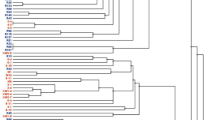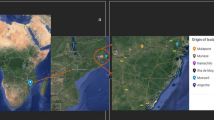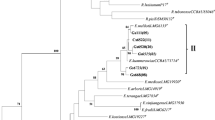Abstract
Polymorphism analysis was performed in Rhizobium leguminosarum bv. viceae populations isolated from geographically distant regions of Ukraine and Middle Asia. Examination of cultural, biochemical, and symbiotic traits revealed interpopulation differences, which were attributed to the difference in conditions between natural ecosystems and agrocenoses. Vetch has high species diversity and is not cultivated in Middle Asia, and the corresponding rhizobial population displayed higher genetic diversity and higher polymorphism of adaptive traits ensuring saprophytic development in soil and the rhizosphere, including melanin synthesis (35%) and active exopolysaccharide production (90%). Strains of the Ukrainian population had a lower exopolysaccharide production (10%), did not produce melanin, had higher herbicide resistance, and utilized glucose and succinate (main components of plant root exudation) as carbon sources. Strains capable of efficient symbiosis with Vicia villosa Roth. had a higher frequency in the Middle Asian than in the Ukrainian population, especially among strains isolated from soil (80 and 35%, respectively). In addition, strains of the Middle Asian population better competed for nodulation. It was assumed that the formation of rhizobial populations in vetch cultivation regions (Ukraine) is aimed at adaptation to ectosymbiotic (rhizospheric) interactions with plants and anthropogenic stress factors, while strains of the vetch original center (Middle Asia) are mostly adapted to the endosymbiotic interaction and to natural edaphic stress factors.
Similar content being viewed by others
References
Sessitsch, A., Howieson, J.G., Perret, X., et al., Advances in Rhizobium Research, Crit. Rev. Plant Sci., 2002, vol. 21, no. 4, pp. 323–378.
Young, J.P.W., Rhizobium Population Genetics: Enzyme Polymorphism in Isolates from Peas, Clover, Beans and Lucerne Grown at the Same Site, J. Gen. Microbiol., 1985, vol. 131, pp. 2399–2408.
Hynes, M.F. and O’Connell, M.P., Host Plant Effect on Competition among Strains of Rhizobium leguminosarum, Can. J. Microbiol., 1990, vol. 35, pp. 864–869.
Laguerre, G., Mazurier, S.I., and Amarger, N., Plasmid Profiles and Restriction Length Polymorphism of Rhizobium leguminosarum bv. viceae in Field Populations, FEMS Microbiol. Ecol., 1992, vol. 101, pp. 17–26.
Laguerre, G., Geniaux, E., Mazurier, S.I., et al., Conformity and Diversity among Field Isolates of Rhizobium leguminosarum bv. viceae, bv. trifolii and bv. phaseoli Revealed by DNA Hybridization Using Chromosome and Plasmid Probes, Canad. J. Microbiol., 1993, vol. 39, pp. 412–419.
Provorov, N.A. and Vorobyov, N.I., Simulation of Plant-Bacteria Co-Evolution in the Mutually Beneficial Symbiosis, Ecol. Genet., 2008, vol. 6, no. 2, pp. 35–48.
Mutch, L.A. and Young, J.P.W., Diversity and Specificity of Rhizobium leguminosarum Biovar viciae on Wild and Cultivated Legumes, Mol. Ecol., 2004, vol. 13, pp. 2435–2444.
Seguin, P., Graham, P.H., Sheaffer, C.C., et al., Genetic Diversity of Rhizobia Nodulating Trifolium ambiguum in North America, Can. J. Microbiol., 2001, vol. 47, pp. 81–85.
Kurchak, O.N., Provorov, N.A., and Simarov, B.V., Different Vicia L. Species Symbiosis Effectiveness with Nodule Bacteria, Rast. Resursy, 1995, vol. 31, no. 1, pp. 88–93.
Vavilov, N.I., Tsentry proiskhozhdeniya kul’turnykh rastenii (Centers of Origin of Cultivated Plants), Leningrad: Nauka, 1926.
Vavilov, N.I., Proiskhozhdenie i geografiya kul’turnykh rastenii (Origin and Geography of Cultivated Plants), Leningrad: Nauka, 1987.
Simarov, B.V., Geneticheskie metody selektsii kluben’kovykh bakterii: Metodicheskie rekomendatsii (Genetic Methods of Nodule Bacteria Selection: Methodic Recommendations), Leningrad, 1984.
Eckhardt, T., A Rapid Method for the Identification of Plasmid Deoxyribonucleic Acid in Bacteria, Plasmid, 1978, no. 1, pp. 584–588.
Rosenberg, C., Casse-Delbart, F., Pusha, I., et al., Megaplasmid in the Plant-Associated Bacteria Rhizobium meliloti and Pseudomonas solanaceum, J. Bacteriol., 1982, no. 150, pp. 402–406.
Beringer, J.E., R-Factor Transfer in Rhizobium leguminosarum, J. Gen. Genet., 1974, vol. 84, pp. 188–198.
Keller, M., Muller, P., Simon, R., et al., Rhizobium meliloti Genes for Exopolysaccharide Synthesis and Nodule Infection Located on Megaplasmid 2 Are Actively Transcribed during Symbiosis, Mol. Plant-Microbe Interact., 1988, vol. 1, no. 7, pp. 267–274.
Pareek, R.P. and Sidhu, B.S., Uncoupling of Phosphorylation in Rhizobium spp. by 2.4D and Tificide-80, Ind. J. Microbiol., 1978, vol. 18, no. 2, pp. 97–100.
Amarger, N., Selection of Rhizobium Strains on Their Competitive Ability for Nodulation, Soil Biol. Biochem., 1981, vol. 13, no. 3, pp. 481–486.
Fesenko, A.N., Orlova, I.F., Provorov, N.A., et al., Direct and Indirect Methods for Testing Competitiveness of Pea Nodule Bacteria, Priklad. Biokhim. Mikrobiol., 1996, vol. 32, no. 3, pp. 352–355.
Sharypova, L.A. and Simarov, B.V., Method for Comparison of Competitive Ability of Effective Rhizobium meliloti Strains, Trudy Vsesoyuznogo Nauchno-Issledovatelskogo Instituta Selsko-Khozaystvennoy Mikrobiologii (Collection of Scientific Papers of All-Union Agricultural Microbiology Research Institute), 1985, vol. 55, pp. 85–90.
Lakin, G.F., Biometriya (Biometry), Moscow: Vysshaya Shkola, 1980.
Nei, M., Estimation of Average Heterozygosity and Genetic Distance from a Small Number of Individuals, Genetics, 1978, vol. 89, pp. 583–590.
Palmer, K.M. and Young, J.P.W., Higher Diversity of Rhizobium leguminosarum Biovar viciae Populations in Arable Soils than in Grass Soils, Appl. Environ. Microbiol., 2000, vol. 66, no. 6, pp. 2445–2450.
Corich, V., Giacomini, A., and Carlot, M., Comparative Strain Typing of Rhizobium leguminosarum bv. viciae Natural Populations, Can. J. Microbiol., 2001, vol. 47, pp. 580–584.
Spaink, H.P., Kondorosi, A., and Hooykaas, P.J.J., The Rhizobiaceae: Molecular Biology of Model Plant-Associated Bacteria, Dordrecht: Kluwer, 1998.
Kuiper, I., Kravchenko, L.V., Bloemberg, G.V., et al., Pseudomonas putida Strain PCL 1444, Selected for Efficient Root Colonization and Naphthalene Degradation, Effectively Utilizes Root Exudates Components, Mol. Plant-Microbe Interact., 2002, vol. 15, pp. 734–741.
Mishustin, E.N. and Shil’nikova, V.K., Kluben’kovye bakterii i inokulyatsionnyi protsess (Nodule Bacteria and Inoculation Process), Moscow: Nauka, 1973.
Serova, A.A. and Makarov, A.I., Vozdelyvanie zernobobovykh i krupyanykh kul’tur v akleolinskoi oblasti: Rekomendatsii (Cultivation of Legume and Grain Crops in Akleolinsk Oblast: Recomendations) Orel: Vserossiyskiy Nauchno-Issledovatelskiy Institut 2008.
Young, J.P.W., Phylogenetic Classification of Nitrogen-Fixing Organisms, Biological Nitrogen Fixation, Stacey, G., Burris, R.H., and Evans, H.J., Eds., London: Chapman and Hall, 1992.
Lie, T.A., Goektan, D., Engin, M., et al., Co-Evolution of the Legume-Rhizobium Association, Plant Soil, 1987, vol. 100, pp. 171–181.
Sullivan, J.T., Patrick, H.N., Lowther, W.L., et al., Nodulating Strains of Rhizobium loti Arise through Chromosomal Symbiotic Gene Transfer in the Environment, Proc. Nat. Acad. Sci. USA, 1995, vol. 92, pp. 8985–8989.
Wernegreen, J.J., Harding, E.E., and Riley, M.A., Rhizobium Gene Native: Unexpected Plasmid Stability of Indigenous Rhizobium leguminosarum, Proc. Natl. Acad. Sci. USA, 1997, vol. 94, pp. 5483–5488.
Author information
Authors and Affiliations
Corresponding author
Additional information
Original Russian Text ¢ O.N. Kurchak, N.A. Provorov, B.V. Simarov, 2011, published in Genetika, 2011, Vol. 47, No. 4, pp. 484–491.
Rights and permissions
About this article
Cite this article
Kurchak, O.N., Provorov, N.A. & Simarov, B.V. Comparison of the adaptive potential for Rhizobium leguminosarum bv. viceae nodule bacterial populations isolated in natural ecosystems and agrocenoses. Russ J Genet 47, 425–431 (2011). https://doi.org/10.1134/S1022795411040089
Received:
Published:
Issue Date:
DOI: https://doi.org/10.1134/S1022795411040089




